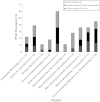Examining a comprehensive model of disaster-related posttraumatic stress disorder in systematically studied survivors of 10 disasters
- PMID: 22897543
- PMCID: PMC3490647
- DOI: 10.2105/AJPH.2012.300689
Examining a comprehensive model of disaster-related posttraumatic stress disorder in systematically studied survivors of 10 disasters
Abstract
Objectives: Using a comprehensive disaster model, we examined predictors of posttraumatic stress disorder (PTSD) in combined data from 10 different disasters.
Methods: The combined sample included data from 811 directly exposed survivors of 10 disasters between 1987 and 1995. We used consistent methods across all 10 disaster samples, including full diagnostic assessment.
Results: In multivariate analyses, predictors of PTSD were female gender, younger age, Hispanic ethnicity, less education, ever-married status, predisaster psychopathology, disaster injury, and witnessing injury or death; exposure through death or injury to friends or family members and witnessing the disaster aftermath did not confer additional PTSD risk. Intentionally caused disasters associated with PTSD in bivariate analysis did not independently predict PTSD in multivariate analysis. Avoidance and numbing symptoms represented a PTSD marker.
Conclusions: Despite confirming some previous research findings, we found no associations between PTSD and disaster typology. Prospective research is needed to determine whether early avoidance and numbing symptoms identify individuals likely to develop PTSD later. Our findings may help identify at-risk populations for treatment research.
Figures
Similar articles
-
Association of PTSD symptom groups with functional impairment and distress in trauma-exposed disaster survivors.Psychol Med. 2020 Jul;50(9):1556-1562. doi: 10.1017/S0033291719001569. Epub 2019 Jul 1. Psychol Med. 2020. PMID: 31258106
-
The Association between General and Pathological Dissociation and Disaster-Related Psychopathology in Directly Exposed Survivors.Psychiatry. 2020 Fall;83(3):292-305. doi: 10.1080/00332747.2020.1716440. Epub 2020 Feb 18. Psychiatry. 2020. PMID: 32069180
-
Psychopathological, biological, and neuroimaging characterization of posttraumatic stress disorder in survivors of a severe coalmining disaster in China.J Psychiatr Res. 2010 Apr;44(6):385-92. doi: 10.1016/j.jpsychires.2009.10.001. Epub 2009 Nov 5. J Psychiatr Res. 2010. PMID: 19896142
-
Exploring the impacts of perceived locus of control on post-traumatic stress disorder among disaster survivors: A systematic review.J Psychiatr Ment Health Nurs. 2024 Oct;31(5):776-787. doi: 10.1111/jpm.13030. Epub 2024 Feb 10. J Psychiatr Ment Health Nurs. 2024. PMID: 38340023
-
The incidence of post-traumatic stress disorder among survivors after earthquakes:a systematic review and meta-analysis.BMC Psychiatry. 2016 Jun 7;16:188. doi: 10.1186/s12888-016-0891-9. BMC Psychiatry. 2016. PMID: 27267874 Free PMC article.
Cited by
-
Impact of Natural Disasters on Mental Health: Evidence and Implications.Healthcare (Basel). 2024 Sep 10;12(18):1812. doi: 10.3390/healthcare12181812. Healthcare (Basel). 2024. PMID: 39337153 Free PMC article. Review.
-
COVID-19 quarantine: Post-traumatic stress symptomatology among Lebanese citizens.Int J Soc Psychiatry. 2020 Nov;66(7):666-674. doi: 10.1177/0020764020932207. Epub 2020 Jun 3. Int J Soc Psychiatry. 2020. PMID: 32489136 Free PMC article.
-
Utilization of Mental Health Support Systems in the Aftermath of Disasters in Japan: Statistical Data of the Miyagi Disaster Mental Health Care Center.Int J Environ Res Public Health. 2022 Aug 31;19(17):10856. doi: 10.3390/ijerph191710856. Int J Environ Res Public Health. 2022. PMID: 36078569 Free PMC article.
-
Socio-demographic patterns of posttraumatic stress disorder in Medellin, Colombia and the context of lifetime trauma exposure.Disaster Health. 2016 Nov 22;3(4):139-150. doi: 10.1080/21665044.2016.1263086. eCollection 2016. Disaster Health. 2016. PMID: 28265488 Free PMC article.
-
Perceptions of Climate Change, Sea Level Rise, and Possible Consequences Relate Mainly to Self-Valuation of Science Knowledge.Energy Power Eng. 2016 May;8(5):250-262. doi: 10.4236/epe.2016.85024. Epub 2016 May 11. Energy Power Eng. 2016. PMID: 29051798 Free PMC article.
References
-
- Federal Emergency Management Agency, US Dept of Homeland Security. Number of declarations per calendar year since 1998 2011 Available at: http://www.fema.gov/government/grant/pa/stat1.shtm. Accessed July 30, 2011
-
- North CS. Psychiatric effects of disasters and terrorism: empirical basis from study of the Oklahoma City bombing. : Gorman JM, Fear and Anxiety: The Benefits of Translational Research. Washington, DC: American Psychiatric Publishing; 2004:105–117
-
- Norris FH, Friedman MJ, Watson PJ. 60,000 disaster victims speak, part II: summary and implications of the disaster mental health research. Psychiatry. 2002;65(3):240–260 - PubMed
-
- Norris FH, Friedman MJ, Watson PJet al.60,000 disaster victims speak, part I: an empirical review of the empirical literature, 1981–2001. Psychiatry. 2002;65(3):207–239 - PubMed
-
- North CS. Epidemiology of disaster mental health response. : Ursano RJ, Fullerton CS, Weisæth Let al. Textbook of Disaster Psychiatry. New York, NY: Cambridge University Press; 2007:29–47
Publication types
MeSH terms
Grants and funding
LinkOut - more resources
Full Text Sources
Medical


